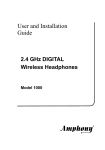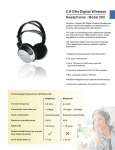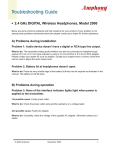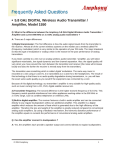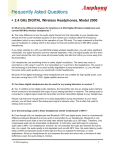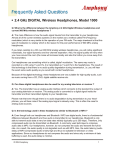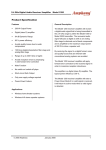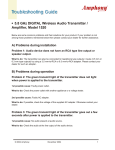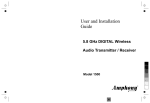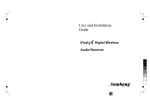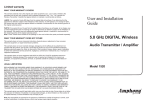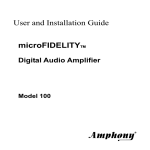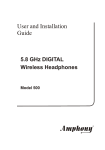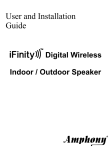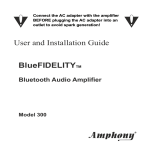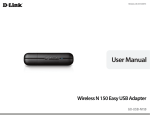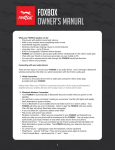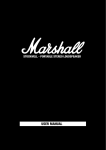Download User and Installation Guide 2.4 GHz RangeBooster
Transcript
User and Installation Guide 2.4 GHz RangeBooster Transmitter R R User and Installation Guide Unpacking: Check that this package contains: One 2.4 GHz RangeBooster transmitter, one AC adapter. How to use the RangeBooster transmitter The RangeBooster transmitter can be used in situations where sufficient coverage cannot be achieved by the primary transmitter and works as a repeater in conjunction with the primary transmitter. In the example below, a pair of 2.4 GHz Digital Wireless Headphones is operated such that there are 4 walls between the transmitter and headphones. In this case, the signal reaching the headphones may be too weak for proper reception. By adding a RangeBooster transmitter as shown in the example, coverage can be improved for the area in which the signal of the primary transmitter was too weak without the RangeBooster transmitter or in cases where there may be interference from other 2.4 GHz devices. Since the audio signal is transmitted digitally to the RangeBooster transmitter, no audio degradation will occur. Primary transmitter Primary transmitter Data cable connection RangeBooster Example 1: Headphones without RangeBooster Example 2: Headphones using RangeBooster, reception is improved The RangeBooster transmitter will reproduce the signal from the primary transmitter and create a secondary coverage area. The RangeBooster transmitter will receive a data signal from the primary transmitter via a data cable connection. The size of the coverage area of the RangeBooster transmitter will be approximately the same as the coverage area of the primary transmitter. Page 1 R User and Installation Guide Step 1 Preparing the Data cable The RangeBooster transmitter requires a data connection with the primary transmitter. This data connection should be established by using a shielded coaxial cable which is fitted with two RCA connectors. This cable is not provided with this set and is available from your local video or satellite equipment dealer. Suitable cables are video and satellite cables with a cable impedance between 50 and 75 Ohms. Examples of suitable cable types are: RG-174, RG-58 and RG-6. Cables with low signal attenuation may improve reception. The cable diameter itself does not influence reception. Unshielded cables may be susceptible to interference and deteriorate the data connection. Data network cables may not provide the correct cable impedance and not guarantee reliable reception. Since the data connection will transfer high-speed serial audio data, it is important to select a cable with the correct cable impedance. If a cable with a cable impedance outside of the range of 50 to 75 Ohms is used, it may be necessary to use appropriate adapters that will convert the cable impedance to 50 to 75 Ohms at each end of the cable in order to avoid a cable impedance mismatch at the transmitter side. RCA connector Data cable RCA connector 50 to 75 Ohms shielded coaxial cable Step 2 Locating the RangeBooster transmitter The location of the RangeBooster transmitter should be chosen such that: the number of walls and obstacles between the RangeBooster transmitter and the headphones / receiver is minimized anywhere in the desired coverage area to improve reception; the cable length of the data cable will be as short as possible (preferably less than 30 to 50 ft) to minimize data signal degradation; and there is sufficient RF signal attenuation between the primary transmitter and the RangeBooster transmitter (no line of sight) to minimize RF signal competition between both transmitters. Elevation as well as the presence of reflecting walls will influence the coverage area of the RangeBooster transmitter. It is suggested to experiment in order to find the best location for the RangeBooster transmitter. Page 2 R User and Installation Guide Step 3 Connecting the RangeBooster transmitter Install the data cable such that the cable length is minimized. Optimum performance will be achieved if the cable length is 30 ft or less. Connect the RangeBooster transmitter power input with the supplied AC adapter. Connect the data cable with the data input at the RangeBooster transmitter and the data output of the primary transmitter. The primary transmitter should be connected as described in the user manual. RangeBooster transmitter DC 9V CABLE ADJUST DATA IN AC adapter Data cable DC 9 V 300 mA Power outlet Connect to “DATA OUT” of primary transmitter. Page 3 R User and Installation Guide Step 4 Operating the RangeBooster transmitter As soon as valid data is received via the data input, the transmit light will light and the RangeBooster transmitter will broadcast a signal. When the primary transmitter goes into standby mode or if no valid audio signal is received anymore, the RangeBooster transmitter will go into standby mode after approximately 1 minute and the transmit light will go out. Transmit light RangeBooster B O O S T 2.4 GHz R The RangeBooster transmitter has to be tuned in order to maximize performance. Tuning will compensate for any data delays that occur while the audio data travels through the data cable. These delays will depend on the length of the data cable. If the RangeBooster is not tuned properly, crackling and disruptions of the audio may occur in areas where an RF signal is received from both the primary transmitter and the RangeBooster transmitter, such as in areas that are located between the primary transmitter and the RangeBooster transmitter. Tuning is done by turning the “CABLE ADJUST” knob. This knob has 16 settings. Find the setting that produces the least amount of crackling and audio interruptions. Audio interruptions can also be minimized by changing the location of the RangeBooster transmitter and primary transmitter (see page 2). Tuning DC 9V CABLE ADJUST DATA IN Page 4 R User and Installation Guide Problems and Solutions Table What is Happening Possible Why RangeBooster transmit light does not light Crackling noise, audio distortion or dropouts at headphones or receiver after the RangeBooster transmitter is powered up, especially when moving the headphones or receiver Range does not improve by using RangeBooster transmitter What to Do Faulty data cable Check the data cable for short circuits and ensure that it is properly connected to the primary transmitter and to the RangeBooster transmitter No audio signal at Check that the primary primary transmitter transmitter´s transmit light is lit and that the primary transmitter is receiving an audio signal Faulty AC adapter Check the power outlet and or faulty power outlet the AC adapter; if possible, check for correct voltage of the AC adapter RangeBooster Tune the RangeBooster transmitter not tuned transmitter as described on page 4 Faulty data cable Ensure that the data cable has the correct impedance and is not damaged Data cable too long Shorten the length of the data cable if possible Poorly chosen Relocate the RangeBooster location of transmitter or primary RangeBooster transmitter as described on transmitter page 2 Strong interference In some cases, there may be strong interference preventing proper reception of the audio signal which can be caused by microwave ovens, cordless telephones, wireless networks or video transmitters. Either eliminate the interference or relocate the RangeBooster transmitter or primary transmitter. Poorly chosen Relocate the RangeBooster location of transmitter or primary RangeBooster transmitter as described on transmitter page 2 Strong interference See under “Strong interference“ above For more information, including a detailed troubleshooting guide, visit the Amphony web site at: www.amphony.com Page 5 R User and Installation Guide Technical Specifications Audio transmission method: Digital (audio data is received via a digital audio data connection) Transmitter frequency: 2.4 GHz Data rate: > 3 Mbps Data Port Cable Impedance: 50 … 75 Ohms Data Port Tuning: 16 settings Data Port audio format: Amphony Data (connects with Amphony devices that provide a Data Out port) Copyright (C) 2003 Amphony. All rights reserved. The information contained herein is subject to change without notice. Revisions may be issued to advise of such changes and/or additions. All product names, trade names, or corporate names mentioned in this document are acknowledged to be the proprietary property of the registered owners. FCC ID PMJT1000 This device complies with part 15 of the FCC Rules. Operation is subjected to the following two conditions: 1) This device may not cause harmful interference and 2) this device must accept any interference received, including interference that may cause undesired operation. Caution: Any changes or modifications not expressly approved by the party responsible for compliance could void the user's authority to operate the equipment. Printed in China. Page 6 Limited warranty WHAT YOUR WARRANTY COVERS This warranty extends only to the original user of the equipment (“you”, ”your”) and is limited to the purchase price of each part. Amphony and it’s affiliated companies (”we”, ”our”, ”us”) warrant this RangeBooster transmitter against defects in materials or workmanship as follows. LABOR: For a period of ninety (90) days from the original date of purchase, if we determine that the equipment is defective subject to the limitations of this warranty, we will replace it at no charge for labor. We warrant any such work done against defects in materials or workmanship for the remaining portion of the original warranty period. PARTS: For a period of one (1) year from the original date of purchase, we will supply, at no charge, new or rebuilt replacement parts in exchange for parts we determine are defective subject to the limitations of this warranty. We warrant any such replacement parts against defects in materials or workmanship for the remaining portion of the original warranty period. Note: ”Parts” means items included in this package. It does not include other parts purchased seperately. WHAT YOUR WARRANTY DOES NOT COVER This warranty does not cover consumer instruction, physical setup or adjustment of any consumer electronic equipment, or signal transmission problems. This warranty does not cover cosmetic damage, damage due to the affixing of any attachment not provided with the product, loss of parts, connecting the product to any but the specified receptacles, lightning, electrical surges, fire, flood, or other acts of God, accident, misuse, abuse, repair or alteration by other than authorized service personnel, negligence, commercial or institutional use, or improper or neglected maintenance. This warranty does not cover equipment sold AS IS or WITH ALL FAULTS, equipment removal or reinstallation, shipping damage if the equipment was not packed and shipped in the manner we prescribe, nor equipment purchased, serviced, or operated outside the contiguous United States of America. LEGAL LIMITATIONS REPLACEMENT AS PROVIDED UNDER THIS WARRANTY IS YOUR EXCLUSIVE REMEDY. WE SHALL NOT BE HELD LIABLE FOR ANY INCIDENTAL OR CONSEQUENTIAL DAMAGES FOR BREACH OF ANY EXPRESSED OR IMPLIED WARRANTY ON THIS EQUIPMENT, NOR FOR ANY INCIDENTAL OR CONSEQUENTIAL DAMAGES RESULTING FROM THE USE OF, OR INABILITY TO USE, THIS EQUIPMENT. UNDER NO CIRCUMSTANCES SHALL OUR LIABILITY, IF ANY, EXCEED THE PURCHASE PRICE PAID FOR THIS EQUIPMENT, EXCEPT TO THE EXTENT PROHIBITED BY APPLICABLE LAW. EXCEPT AS PROVIDED HEREIN, WE MAKE NO WARRANTIES, EXPRESS OR IMPLIED, INCLUDING WARRANTIES OF MERCHANTABILITY AND FITNESS FOR A PARTICULAR PURPOSE. WE RESERVE THE RIGHT TO REFUSE TO HONOR THIS WARRANTY IF WE DETERMINE ANY OF THE ABOVE EXCEPTIONS TO HAVE CAUSED THIS EQUIPMENT NOT TO HAVE PERFORMED PROPERLY. THIS WARRANTY SHALL BE VOID IF ANY FACTORY-APPLIED IDENTIFICATION MARK, INCLUDING BUT NOT LIMITED TO SERIAL NUMBERS AND WARRANTY LABELS, HAS BEEN ALTERED OR REMOVED. THIS WARRANTY SHALL ALSO BE VOID IF THE TRANSMITTER OR HEADPHONES HAVE BEEN OPENED BY AN UNAUTHORIZED PERSON. This warranty gives you specific legal rights which may vary from state to state. Some states do not allow the exclusion or limitation of incidental or consequential damages, or allow limitations on the duration of an implied warranty, so those limitations may not apply to you. Note: No responsibility is assumed for the presence of interference outside of Amphony’s control, such as other transmitters or microwave ovens, which may hamper proper signal reception.








